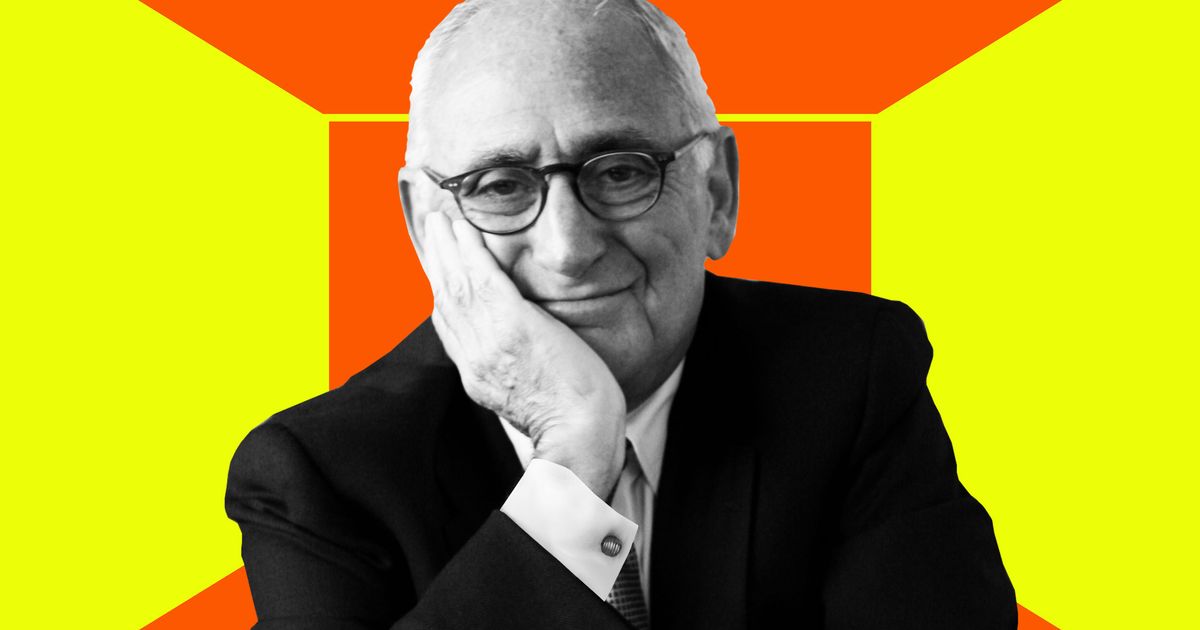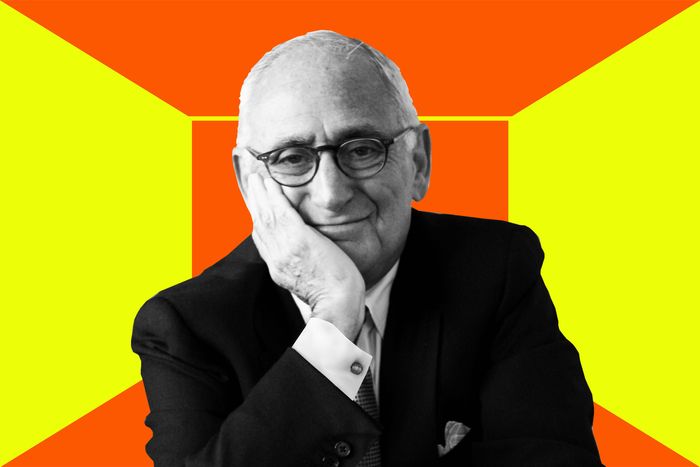
21 Questions With Architect Robert A.M. Stern

Photo-Illustration: Curbed: Photo: Courtesy of RAMSA
New York’s “21 Questions” is back with an eye toward creative New Yorkers. Robert A.M. Stern and his 300-person architecture firm have designed more than 45 buildings in New York City, including 220 Central Park South and the downtown Four Seasons Hotel. He’s currently writing his 40th book, and his new memoir, Between Memory and Intervention: My Journey in Architecture, co-authored with Leopoldo Villardi, is out now from Monacelli Press.
Name: Bob Stern
Age: 82
Neighborhood: Upper East Side
Occupation: Architect, historian, and educator
What’s hanging above your couch?
Behind me right now are photo-realist prints I acquired in the 1970s from artists like Ralph Goings and architectural drawings from when Max Protetch had his gallery in SoHo, ranging from John Hejduk to Gunnar Asplund and Eliel Saarinen. Most of the art I was collecting from the 1960s to the 1980s had a realist tendency, whether it was Andy Warhol or Roy Lichtenstein or these artists. Now, I no longer engage in the art world.
What’s the first job you had in New York?
One, or maybe even two, summers during high school and the beginning of college I worked for a printer in Lower Manhattan responsible for legal documents. I would be given documents to deliver to lawyers. I was a messenger but they called me an “office boy” because it sounded more tony. It gave me a chance to wander around Lower Manhattan, which was my first architectural love.
What color are you always drawn to?
I’m drawn to the idea of color. I don’t see things in black and white. Le Corbusier’s later work exploded with color and that was a great influence on me very early on. A hallway in our office, where we hang watercolors of our early work, is painted a pale pink. Other areas in the office are yellow and pastel green.
What art or artifact are you most surprised you own?
I’m inherently eclectic by nature. My then-wife and I acquired together a very early piece by Donald Judd. It’s super minimalist and totally abstract. Somebody said it looked like a barn door. I subsequently put it up for auction a few years ago and I believe it’s in the Prada Foundation now.
Which New Yorker would you want to hang out with?
I like to be around people who are smarter than I am, not people who are dumber than I am, and that severely limits my friendship circle. But who would I want to be with on a desert island, quote un quote? Jaque Robertson, recently deceased, was my oldest friend in architecture and he was extremely smart, cosmopolitan, and had such great cultivation. He had a great sense of the history of architecture and was instrumental in forming the urban design group during the Lindsay administration, which was so important to the city.
What’s the last thing you made with your hands?
I make sketches all the time for projects. I’ve been doing them over Zoom recently. Last Friday, we were working on a new residential tower for the Upper East Side and I drew some suggestions for how to re-plan some of the units. There was an element on the facade, which I thought was out of scale and I changed it. I’m still of the school of Paul Rudolph, my teacher, who said when you pose your pencil over the paper, that’s the key creative moment. You make a sketch and you develop it. Since I’m not really the most brilliant artist, other people work on my sketches and develop them and I act as an ongoing critic.
Is there one thing you own multiple versions of?
Yellow socks. I took to wearing colored socks and I became quite careful selecting the patterns. Someone said to me, well, Fred Astaire always wore pale yellow or pale blue socks, so I adopted pale yellow. I have a bunch of pale blue ones when I run through the yellow collection. I’m wearing my yellow socks as we speak. I worked on the Bush Library in Dallas. And President Bush likes to give nicknames to people and he dubbed me “yellow socks.”
What New York City museum do you always go back to?
I love to support the Met, MoMA, and the Neue Galerie. I don’t support the Frick with my money, but I support it with my soul. It’s a fabulous place. Mr. Frick put together some amazing paintings and it’s so interesting to see them in a domestic setting.
What do you always have next to your computer?
New books and journals we subscribe to — Architectural Record; The Architectural Review; Country Life, which I think is one of the most beautiful magazines published; and The Journal of Architectural Historians.
Where is the best view of the city?
When I was a kid, it was the front window of the F train when it’s coming across the viaduct over the Gowanus canal. From afar, Manhattan looked like a Metropolitan Oz. Today, I don’t know. I suppose on the top of the Empire State building, which I visited many times as a kid. Now you have One Vanderbilt, the Edge at Hudson Yards, and of course you have wonderful views from many of our tall apartment buildings, whether it’s 30 Park Place or the balconies in 520 Park Avenue or the super terraces atop 15 Central Park West, to name a few.
What building or object do you want to redesign every time you see it?
Oh my god — there are so many tall buildings in Manhattan and now in Downtown Brooklyn that I can’t believe anyone ever approved. They’re hardly works of architecture; they’re packages of accommodation. The skyline I knew as a kid taking the F train was mostly developed up until 1932, when the Depression drew a halt to the construction of skyscrapers. The Lower Manhattan skyline with its pinnacle towers — the Cities Service Building, 55 Exchange Place, 1 Wall Street — was a thrilling view. I loved the way those towers rose atop the early- and mid-19th century mercantile buildings. I would take down all those flat-topped buildings along the East River. The Chase Manhattan Bank is the first and only wonderful flat-topped building I know. The rest of them are junk.
What’s one thing you would change about your field?
I love being an architect and I love practicing architecture. But the amount of time each architect spends in trying to get projects and doing elaborate responses is perhaps time not so well spent. Each of us has drawers full of requests for proposals fulfilled, but not awarded.
If you could live anywhere in New York City, where would it be?
I’m very happy where I am now, at the Chatham, which our firm designed. When the building was constructed, I was given the opportunity to make some very special changes, including some dramatically placed French windows and balconies overlooking a garden behind the building. My apartment faces west over a garden, I get south light, I get north light, I have high ceilings. It’s a pretty good situation. I’m happy as a clam.
What would you hoard, if it stopped being produced?
My yellow socks! I have hoarded them. I have dozens of them!
What do you do to get out of a creative rut?
I look at books and study the architecture of the past. I don’t spend so much time studying the architecture of the present, a lot of which doesn’t inspire me. I do have some contemporaries, who inspire me by their work, or at least their zest for life. But by and large, I like to go backwards to go forward. We have a very large library in the office, about 18,000 books.
Where was your first NYC apartment and how much was the rent?
My first real apartment was at the Century at 25 Central Park West. I had fantastic views of the park. If you leaned out of the casement window — at some slight peril to your life — you could see the brand-new opera house at Lincoln Center. This was in 1966, right after I got married, and I don’t remember the rent. We lasted there about a year and a half.
Where in the city do you go to be alone?
I love to go walking in my neighborhood.
What’s the worst piece of career advice you’ve ever gotten?
Someone told me not to accept the commission for the George W. Bush library because this person didn’t approve of Bush’s politics. I said it wasn’t a political commission — and I’m a registered Democrat — it was an architectural one. I was designing a library for researchers to actually research the Bush administration and its policies and those papers are owned by the public of the United States.
What have you given away to someone that you wish you could get back?
Once in a while, I’ve lent a book and never seen it again. But I’ve taken up the policy of neither a lender nor a borrower be. If I want a book, I buy it. If someone wants the book, I suggest that they go and buy it themselves or go to a library.
What’s your favorite NYC restaurant and regular order?
I’m a great admirer of the Gramercy Tavern and I miss it very much. I haven’t been there since the pandemic, since I haven’t been anywhere. I also love the Oyster Bar. With our new office at One Park, I could hit the Oyster Bar on my way home. I’m not a fanatic foodie at all. I like eating in a nice room and I like the nice hum of sound that you get at Gramercy Tavern, for example. The food is nice, but if you asked me a half hour later “What did you eat?” I can’t remember. But I will always have a martini.
What descriptive phrase do you want on your obit headline?
I have no idea! That would be too egotistical to say, even for me. I would love it if someone would say something nice about my architecture, my love of cities — New York City, especially — and my support for young architects in my practice and as a teacher at Columbia and then as the Dean at Yale.
